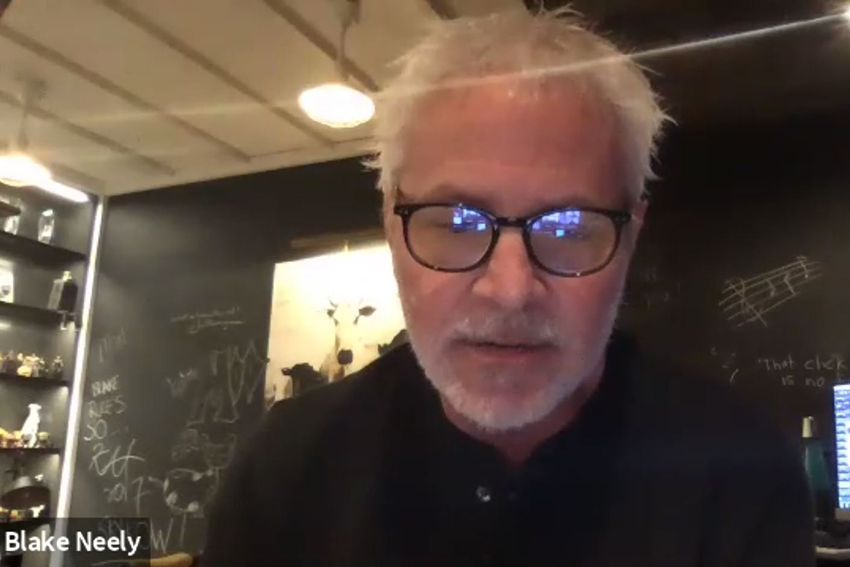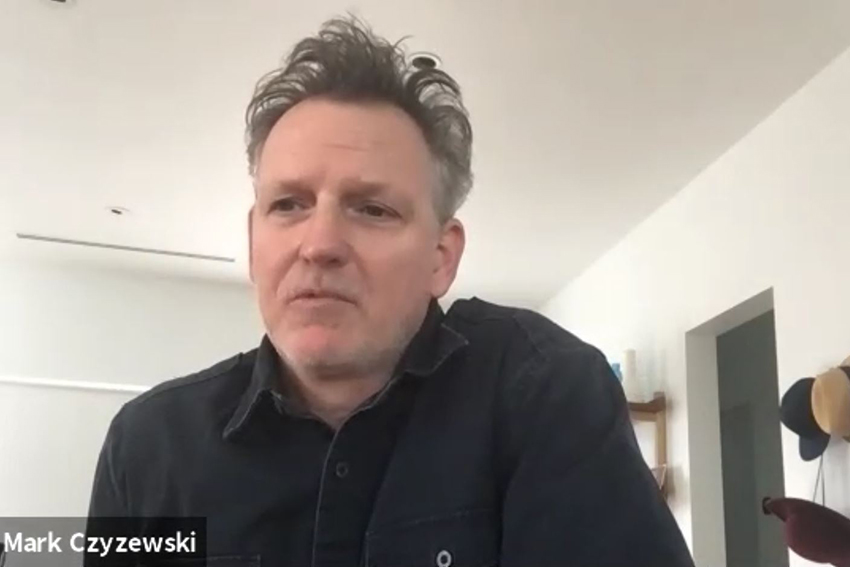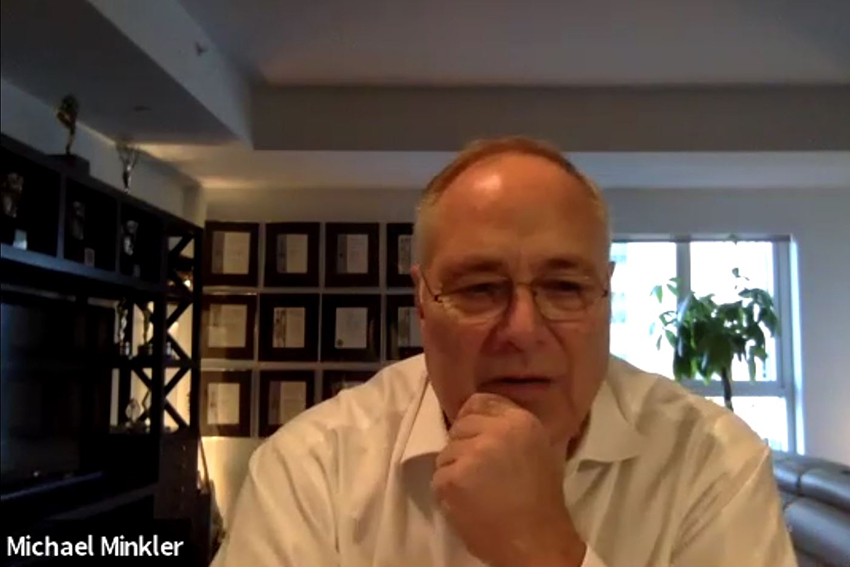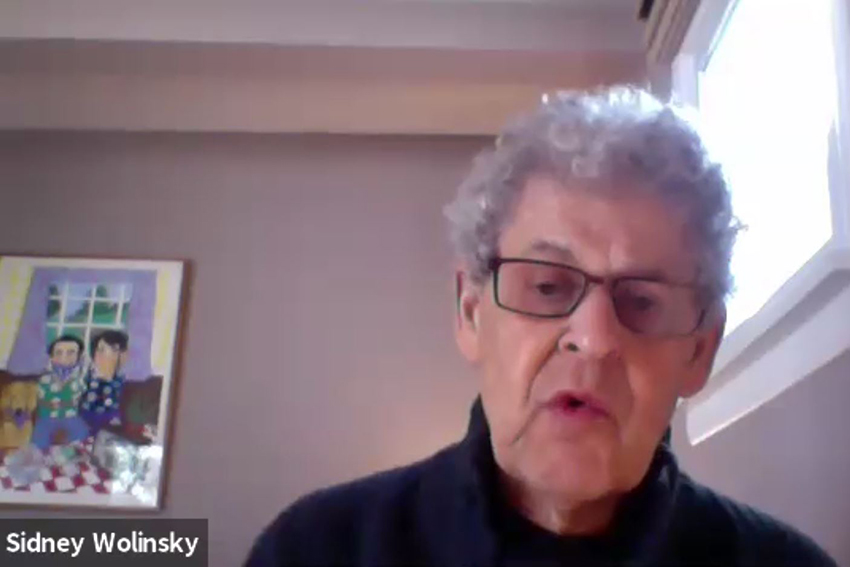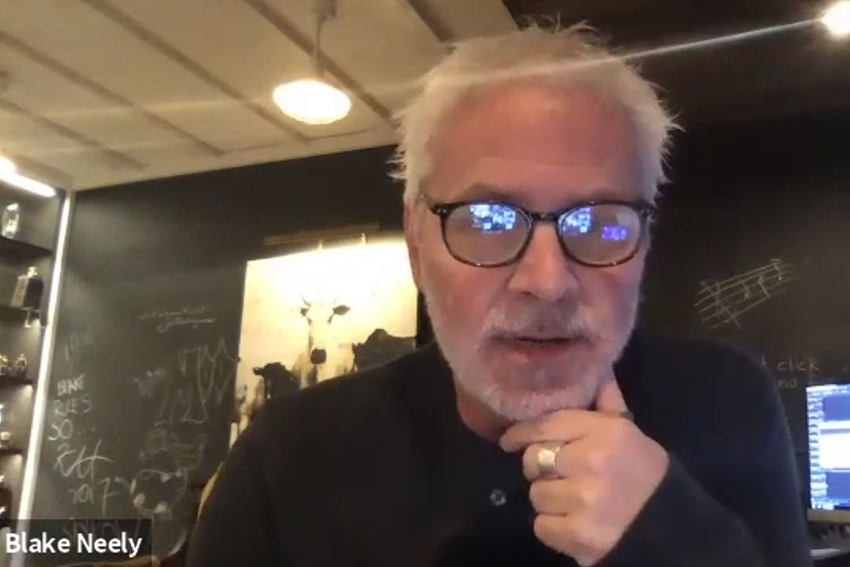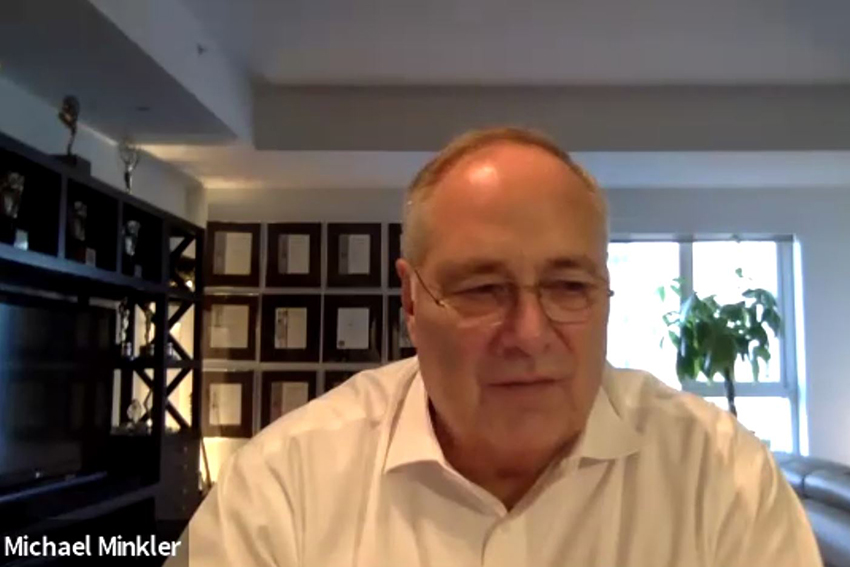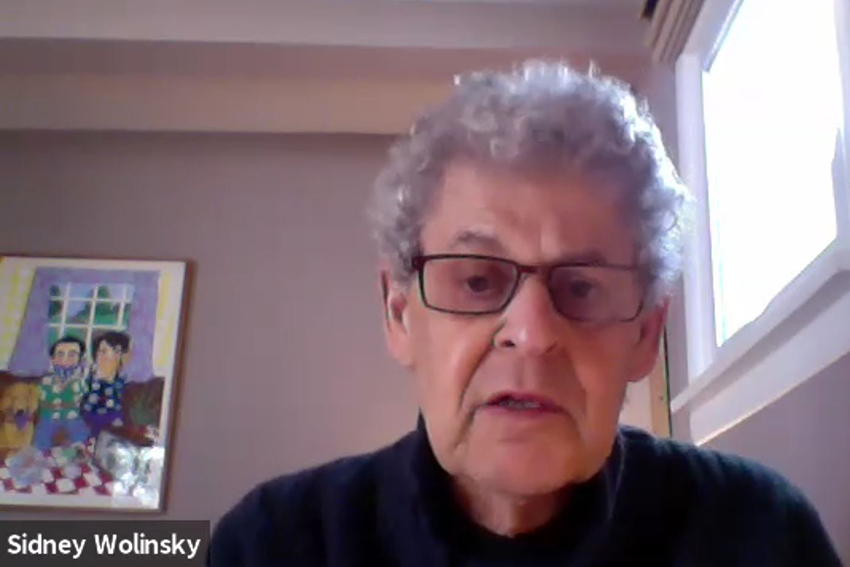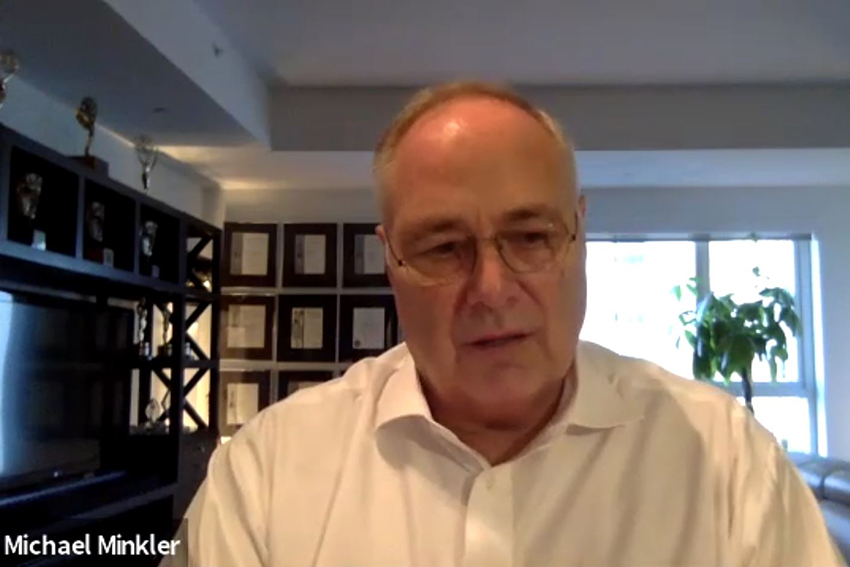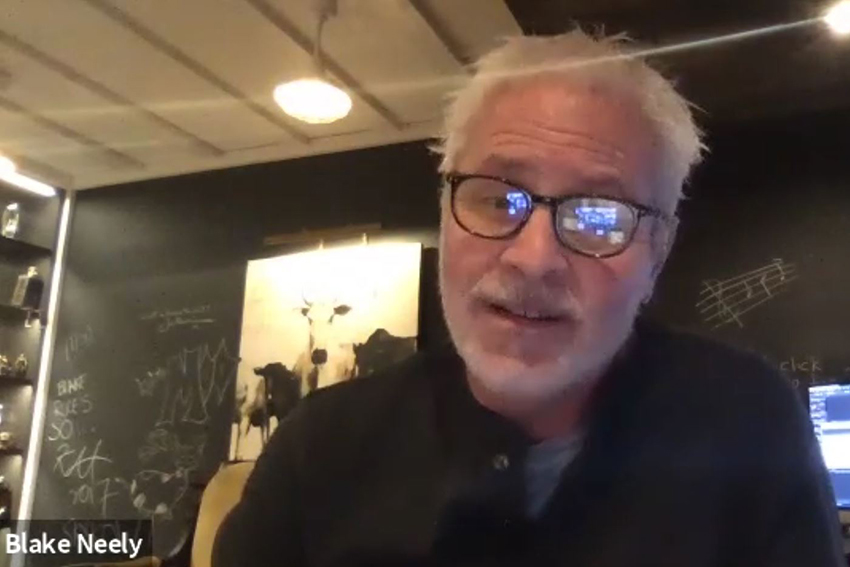AppleTV+ - GreyHound – Blake Neely, Michael Minkler, Sidney Wolinsky & Mark Czyzewski virtual press conference
By Mulder, Zoom Event, 08 january 2021
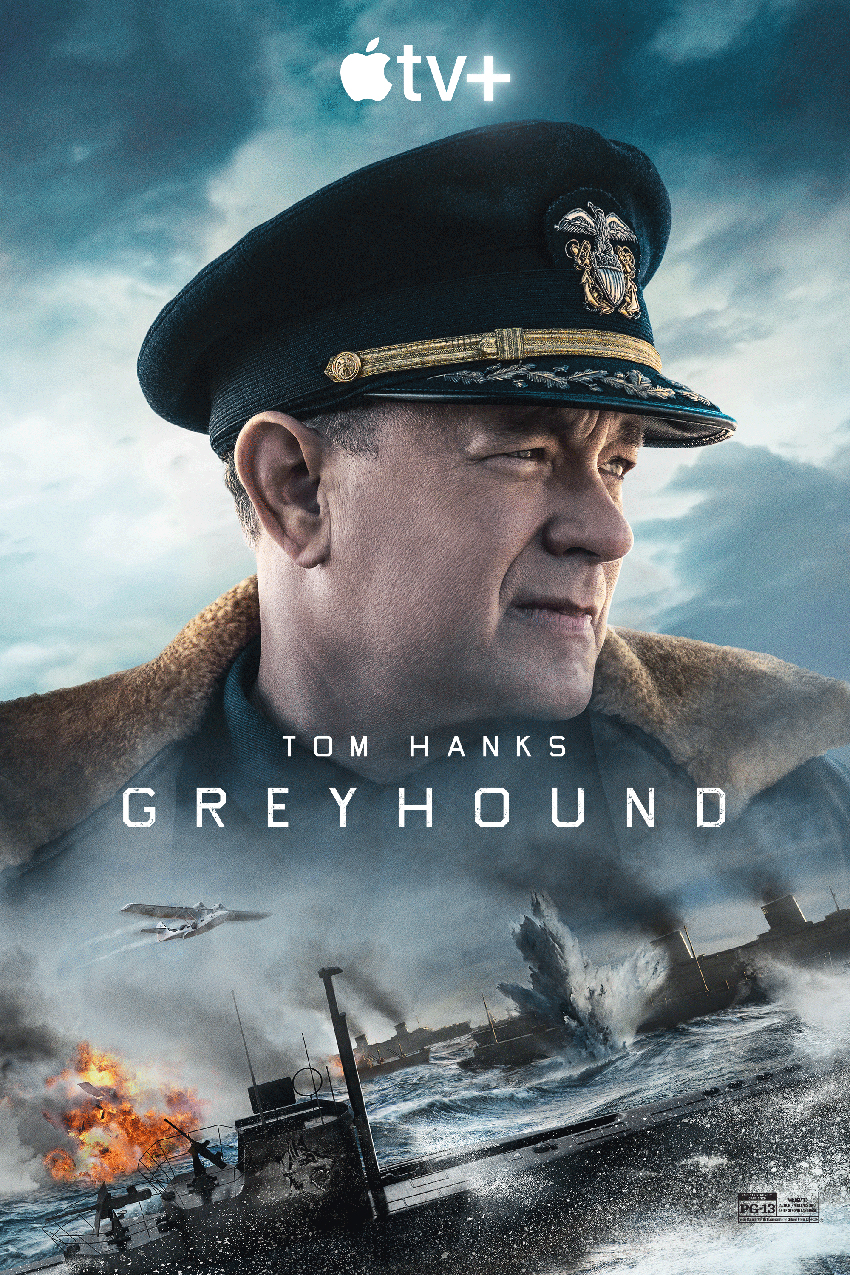
Greyhound is a 2020 American war film directed by Aaron Schneider and starring Tom Hanks, who also wrote the screenplay. The film is based on the 1955 novel The Good Shepherd by C. S. Forester, and also stars Stephen Graham, Rob Morgan, and Elisabeth Shue. The plot follows a commander of the US Navy on his first war-time assignment in command of a multi-national escort group defending a merchant ship convoy under attack by submarines in early-1942 during the Battle of the Atlantic, only months after the U.S. officially entered World War II. Greyhound was initially scheduled to be theatrically released in the United States on June 12, 2020 by Sony Pictures Releasing, but was eventually cancelled due to the COVID-19 pandemic after previously being delayed indefinitely. The distribution rights were then sold to Apple TV+, which released the film digitally on July 10, 2020. It received generally positive reviews from critics, with praise for the action sequences and effective use of the 90-minute runtime. Greyhound is a Playtone Production from Sony Pictures Entertainment/Stage 6 Films, in association with Bron Creative, Zhengfu Pictures, Sycamore Pictures and FilmNation Entertainment.
Today we were invited to a virtual press conference with members of Aaron Schneider's Greyhound team, available since July 10th on Apple TV+, to discuss with cinematographer Shelly Johnson, costume designer Julie Weiss, production designer David Crank, Composer Blake Neely, Sound Designer Michael Minkler, Editors Sidney Wolinsky & Mark Czyzewski and Visual Effects Supervisors Nathan McGuinness + Pete Bebb.
Q : hi guys thank you for taking the time out of your day to speak with us this question is for Michael because you are no stranger to the oscars and we are gearing up for award season and all our for your consideration coverage so especially during this year where things have been crazy, Greyhound has faced the obstacle of not having a theatrical release what does it mean to you to have buzz around a movie awards buzz around a movie that you worked on and how is it compared to like last year when you went to the Oscars.
Michael Minkler : well for me Greyhound was really special because of the amount of care and attention that went into it and it did go on for quite a long time and we took two separate passes at it a year apart from each other the whole process for me lasted almost two years so to see it come from where it started to where it ended was extremely gratifying it literally was like watching a child grow up so that's what my biggest takeaway is just i was so happy everybody was so happy at the end result.
Q : anyone can answer that
Blake Neely : well , I’ll say what was what has been remarkable about this movie is you know without under normal circumstances it would be gone from theaters and Apple's done such a tremendous job with this film that it's if you turn on your apple tv it's like it just got released so this film has been going for six months like it's a first run movie and none of us uh thankfully approached this as if it would be some kind of streaming lesser than and so i think that everything's on the screen as far as how epic it turned out. Mark's still editing right you're still editing working on the film.
Mark Czyzewski : for me, it was just very gratifying again to see how you know the audience really did have a thirst for kind of all the information and uh the pace of it and everything we packed into it and every time we screened it for the audience it just kind of it was remarkable how interested they were in the subject so it just was really great that it kind of came out the way it did and so many people have been able to see it in light of you know where we are right now.
Q : hi guys thank you for taking the time to talk to us today. My question is for Mark, this film is such a fast-paced high-intensity film and I just wanted to know what the editing process was like and making sure, that we got that fast pacedness but also spent ample time with the characters as well during all the chaos.
Mark Czyzewski : I mean that that was always the focus you know maintaining that pace and the thrill while maintaining the clarity for the audience through all the naval jargon and all the information we throw at them it really was a painstaking but you know very rewarding process and again it seemed every time we screened it for a test audience their appetite was strong for the all that info and I just you know and with the VFX and everything we just kind of always focus on telling the story from Krause's perspective so yeah that's how we kind of maintained our pacing et cetera.
Q : hi everyone I’m kind of curious maybe it's my biology background talking but was there part of the score or the sound design that incorporated whale sounds and if that's true I’m curious what is the inspiration for bringing natural sounds into something that is like this cold metallic world of battleships and U-boats
Blake Neely : well that's me, I’ll take that i think Mike was very happy that i didn't use actual whale sounds but they were the inspiration i wanted to create this otherworldly I see this movie as part modern thriller part period piece and part horror movie and so the horror aspects of it are these lurking U-boats below and i wanted to give them this otherworldly sound that you couldn't really tell what it is. It a synth is it a whale is it a which it is a violin being played very poorly through a bunch of effects and there are other instruments played very poorly through effects but by doing that it it's a human playing this weird sound which i think gets a little bit more into your skin but definitely it's called the whale sounds now Mike you even i think you termed it the whale sounds and i have to take that because that was the inspiration.
Michael Minkler : sorry i don't know it was either Gary or myself who gave it the nickname the whale sound but it was it was used very well and because of your modular construction of your music we were able to move those things around when best needed there's lots of different parts of the orchestra that's the way Blake delivers it and so being modular like that you can refer to different pieces of music and use them wherever you whatever's used best because things are always changing and evolving this movie evolved because it was Tom's movie he wrote it produced it he just kept pouring more ideas on it more ideas and so the movie was always shifting and changing so that was one of the great joys to watch it mature and it matured with the music and then matured with additional dialogue matured with everything of visual effect,s oh my gosh, how it matured so it's all everything sort of had to be modular to perform its best at all times no matter what Tom had in mind we had to be able to deliver some something that would enhance it.
Blake Neely : I’ve worked with Mike several times and the best way to work with Mike is to give him a toolbox of ideas and then come to the playback and having seen the film 50 times myself be again surprised if as if it's new with this new mix and you put that there that scared me so it's that's always a treat
Q : hi there, I’m curious for any of you what past movies or television shows either that you've worked on that you haven't, served as positive inspirations for the kind of mood you wanted to convey here.
Mark Czyzewski : I’d say one of them would have been the Pacific mini-series you know with HBO with also with Playtone and Michael and Blake as well just kind of a very similar kind of feel about the two projects i'd say for me.
Michael Minkler : well for me it was you know I’m a big fan of world war ii movies anyway and i've watched quite a few submarine movies I’ve watched a lot of you know battle of the north Atlantic films and they're all very good in their in various ways i think this way what we talked about early on was not only its authenticity but we had to keep the thing moving and because it's a rush the whole movie is about they've got 48 hours or something to get across this black zone that they call in and so everything had to be rushed and the fact that they're being chased and they have to chase back after the submarines and then go to protect another ship and then go to rescue another it had to be frantic for you know 90 minutes of just frantic but yes we do it we have some pauses because you can't take too much of that but so the inspiration from other movies was just take the best of those scenes those moments in those other movies and sort of pile and put them together construct them together towards this moving movie moving.
Blake Neely : i guess for me it was you know all my work on the superhero tv show genres kind of prepared me because i saw captain Krause as a superhero and learning how to keep that tension up through seasons after seasons this was one battle after another with maybe a 30 frame respite between but also i was very inspired by some classical music that I in particular Chostakovitch symphony which i wanted to sort of make the score feel like it makes me feel when i listen to it and it just has this forward propulsion that i thought well, that's cool.
Q : hello Blake the music plays an important part in the success of this great movie which are for user main differences working on such popular and amazing series dc and a movie like this one ?
Blake Neely : i think the biggest difference is with those shows you kind of have to be really bigger than life because they aren't real people they're superheroes running around in in costumes and while i try to find their humanity through the score it tends to be way more operatic with this it's back to the old film scoring rules which are stay out of the way support and have your moments where you need to and what i try to do is whenever there was a down moment is really return it to a very comfortable known orchestral warm sound so that when the tension's tense it's make it stop please make it stop can I go back to that nice oboe for a second and as my daughter said when we were watching it towards the end of the film there's a moment where Tom thinks it's over and it starts and she says he just put his slippers on so that's kind of the feeling we're all going for is that is it over no it's not.
Q : Hi Gentlemen it sounds like for Blake and Michael that the two of you work together a lot especially to incorporate sounds into the score and also for Mark a question of how what kind of shape the film do you get as far as the visual effects and stuff like that when you start to add.
Mark Czyzewski : yeah i mean it was you know the VFX were all just you know at that point post fizz wireframe type stuff there were some you know we put some score in and it all just kind of comes together from there and you just initially you could feel how strong and what a worthwhile thing it was to you know working towards the ultimate goal it just was a very powerful thing from the get-go so yep.
Blake Neely : i thought what was cool with Mike and Mark was that we had so long we got to revisit this twice as Mike said earlier because when I’m working on a print I don't have the visual effects i don't have the sound effects I’m just hoping that it's going to work and so on our first mix i remember realizing that some of the cool sounds that Mike was coming up with are in conflict and so by the time we got to the second round we really had a cohesion of you go low I’ll go high you go scary I’ll go emotional and that that took the three of us for a year like going back and forth and throwing ideas back and forth so that is the good thing about lasting so long
Q : this is a question for everyone and it's kind of a possible like advice question for viewers at home but because this movie was released on Apple tv plus instead of theaters what would you say is your best advice to kind of recreating the theater experience from home especially when it comes to possibly recreating the immersive experience or getting the best possible picture and sound quality
Michael Minkler : Well, I when i first heard it and saw it on tv, i had some concerns but they were just concerns that i had to I wanted to follow up on so i did talk to the Apple engineers and they were very helpful actually i spoke to them before we actually before the release we had made a special streaming version of the sound mix and so i confirmed with them at that point and then we convert again once we finished it and then we conferred again when they gave me uh like a test run that I could do in my own home tv and then when the actual release came so i was always i was in contact with them quite a bit and um it is for me it is very difficult to transition from a big stage you know that's 60 feet by 50 feet with a 40-foot ceiling mixing in Atmos with you know 40 000 watts of power pushing speakers pushing you know 80 speakers it's quite a bit different experience so where i ended up with the conversations with all the Apple engineers was the best way to for you to receive this these presentations both with picture and sound is to get the latest equipment they sounded more like salesmen at that point but i believe it to be true the latest receiver being the apple box uh the latest smart TV would have the better sound obviously sound separate sound systems whether they be 5171 or Atmos anything you can do to upgrade your own personal experience at home is valuable and good and it's not that you have to because these mixes are and the picture are designed to play across multiple formats so just give yourself the best shot at it and if you have your own personal little theater at home would be the optimum then you could like customize it any way you want but most of us don't have that so it's just the more you the better you want it is there's more money you spend.
Blake Neely : i was able to get these, you know these index and I’m a sound guy but I got one of these inexpensive sound bars it's an Atmos sound bar with a sub and it's terrific and you know you have to remember that film is front lit and tv is backlit so you need to you know blacken the room as much as you can and don't forget popcorn.
Michael Minkler : as far as the picture goes one thing i can say is that Gary Goetzman our producer had a challenge with the timing of the picture with the visual aspect of the coloring colorization and the brightness in the tone because the Apple's first instinct was to make it as gorgeous as possible and he had to pull them back from that this is i want it look more vintage you know i like the grays I like the blues and so he had to tweak it so that it optimized what he wanted and it satisfied the Apple engineering people with what they wanted.
Q : I’ve actually got two questions and these questions are precluded with a warning to the audiences who have not yet watched this spectacular Greyhound. I’m spoiler alert for those who have not watched this. My first question is exclusively for Sydney for his amazing editing skill for this film one of the scenes that really hounds me to this very moment is that scene when the battle ravages on the ocean the camera suddenly tilts off to the heavens what the sign philosophy was behind an amazing scene.
Sidney Wolinksy : that scene was in the script and i understand it was sort of to show the scope of the battle and give you a sense of how i mean for me i mean i can't speak for Tommy or whatever but it's a sense of how you know humanity is down there fighting killing each other and in the distance is the aurora borealis which is sort of eternal and these battles are just sort of ultimately totally insignificant in terms of humanity that's sort of my understanding i don't know whether anyone else wants to you know give their explanation of it. I just thought it was a sort of a beautiful moment that kind of takes you out of the heat of the battle and gives you perspective on what war is in terms of the i don't know the time frame of all mankind and you know and more.
Q : my second question is for everyone is there any particular scene that hounds you to this very moment because of its utter power and magnificence.
Blake Neely : well I’ll say that one in particular that you mentioned Marvin but the ending still gets me moves me to tears i see it as bittersweet i don't see i mean it's heroic and it's a job well done but it's very bittersweet i mean it's only the beginning of the battle and what is about to transpire changed the world and many lives were lost so that one still gets me.
Mark Czyzewski : yeah for me it's kind of the same thing it's at that moment where he receives the call from the help and he gets his orders to kind of stand down and he takes his orders quietly and he's done his job and he goes to finally can get some rest and it just very you know quietly goes and you know gets his rest and we'll wait for he'll probably end up going back the other way across the ocean again so yeah that was for me that's the strongest moment .
Sidney Wolinksy : yeah for me it's when he gets his first kill you know the long kind of search for the submarine early in the show and then the crew is cheering and we realize that Tom Hanks realizes the weight of what he's done and the horror of it and how he and probably alone there realizes the you know the awful meaning of what you know what this accomplishment was and that it can't be an unmitigated you know you can't really cheer the death of 50 men who regardless of who they are that's a powerful moment.
Q : two-part question i wanted to apologize if it's been asked already I came in a bit late but the first one's for Michael and i was just curious about how you went about determining the sound of the boats and the weaponry in terms of making it authentic to the era but also unique so it had allowed the film to separate itself from a lot of other world war II era films and the second half is for Blake basically how did you go about deciding to mix say military themes and military style music with the music of the era to you know give it full immersion. Thank you
Michael Minkler : well when it comes to the gunfire and the ordinance that's used in the film obviously authenticity was something that everybody wanted and that was our starting point so all of these guns you can find the original material in libraries now what makes it different and it makes it different on any movie with any sound designer is what do you do how far do you take it from there from the from its original source you obviously we're making a movie we don't want it to be strictly authentic so you want to be dramatic you want to be exciting you want people to like give you know knock them off their seat if you can, you know when the big guns go off so you just sweeten them you can sweeten them with five different new elements or 10 or 20 new elements but it's there so that's just to taste and we experiment with different sizes and shapes of all the guns they all want to sound unique they all want to sound powerful and beautiful and scary so it's an emotional thing the guns have to be emotional they did they're not there to just go bang they are there to excite and amaze you because if you can imagine a real destroyer that has so much weaponry on board it's going off at the same time plus they're being shot at it's got to be pretty horrifying and these are not just rifles that are going off this is you know high caliber big time guns and there's with big time explosions so you want it to be amazing.
Blake Neely : for the music's question, I decided early on to use anachronistic sounds you know synthesizers weren't available during the war but i felt like just to put a period spin on it like we did with the pacific was this was more of a modern film set in older times and it also allowed for this back and forth between the reverent hymnal qualities of the score being the tried and true orchestra in a very set setting while the action could be angular and big right turns and weird sounds that you're not accustomed to and that that was the approach there.
Q : hello, the film has this creepy scenes where the german enemies proclaim the imminent death of the crew over the loudspeakers I wanted to know how did you approach these scenes how did you all approach them from capturing the face of terror of everyone to designing the sound atmosphere to having the perfect music to accompany everything.
Mark Czyzewski : so much of it was it was in the script and i think again as we started getting more and more of the pieces together it kind of you know there was just a natural kind of evolution you know the music and the sounds and when we had all the toolbox and the VFX it you know we just kind of all it just kind of came together that way it evolved .
Michael Minkler : well just having all the different tools that you can at your disposal and making those choices and it's a frame by frame what can be heard here which should be heard here. Do you want to hand it over in favor music you want to hand it over in favor sound effects of course dialogue always needs to be a concern it must be heard at all times so it's literally a frame by frame kind of decision making process there's a lot of music in this movie there's probably 85 minutes of music in a 92 minutes movie and as well as a lot of warfare and dialogue so it the trick is to have hear that music without hearing the music use the music use the sound effects use the dialogue the best way you can on a frame by frame basis
Blake Neely : and also, it's the magic of going to a mix i mean mark when he was cutting this the voice of the German of the head of the wolf pack was a completely different voice in his cut in my cut every time we mixed it and then, you know they changed the voice a couple of times it got scarier everything got scary it was cut tighter Mike mixed it scarier but to that to that point there's so much like Mike was saying there's so much going on but there's also in the first two reels of the film there's so much lingo that you don't understand this military only people on ships and so you're having to stay out of the way of that and make sure that the right words are understood.
Q : hi guys, this question i think is for mark or Sydney, for everyone we've spoken with just said that Tom came into this he had very specific ideas about what every aspect of the movie and I’m wondering what's that like from the editing standpoint to work with someone as a very specific idea of things as opposed to working on a project where it's a little more up in the air
Mark Czyzewski : yeah with Tom who's always just you know he has a great deal of respect for the audience and you know uh gives always gives them credit. You know they'll get it and you know and it's just he's always just focused on you know the meat of the story so again as this is all told from Krause's perspective more or less and he was always there to remind us of that and always you know as you would imagine keeps the room light and you know it's a good creative environment.
Sidney Wolinksy : Tom’s intention was that the whole show would be from tom's point from the Krause point of view and i think that was stuck to pretty closely so i think that was one of his major concerns that it'd be and i know the novel also was a very interior novel so he wanted that probably to honor that.
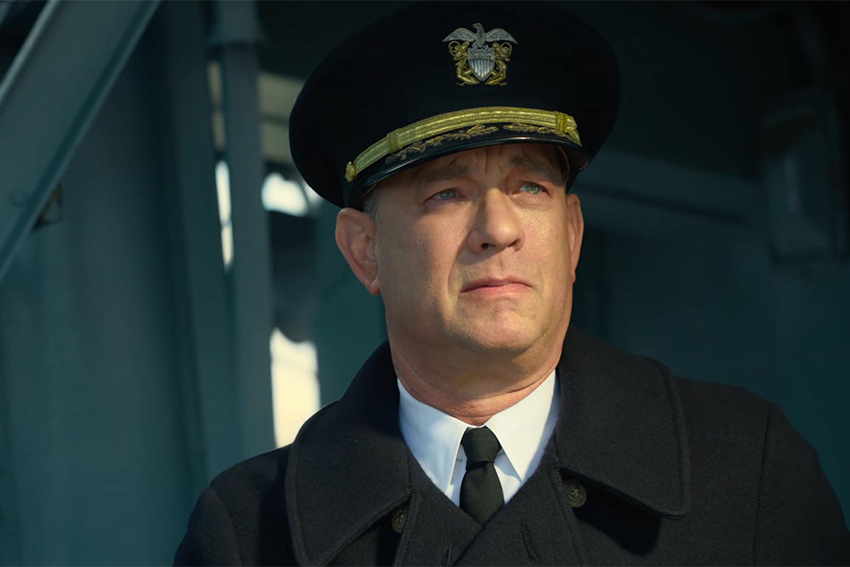
Q : today my question is for Mark and for Sydney, in watching the movie i was struck by the amount of specific detail that the audience is able to internalize about warfare i wrote actually that it was sort of how trigonometry won the war and i was curious to hear your thoughts on the challenge of conveying that much technical information alongside the sort of visual representations of the warfare that all that material denoted I’d love to hear your thoughts thank you.
Sidney Wolinksy : well i could say one of the challenges for me was to figure out what was going on and luckily our director who used to be a DP is very smart and understood all the minutiae of everything in terms of internally he could tell me how many shells would needed to be shot for to in reality to kill a sub or there's like different sonar there's like a slow sonar and a fast sonar and you know one is for what you know the closer the submarine gets to you switch to the fast sonar because it's coming so quickly you want the pings to happen faster they're just and all of that was really i mean that's sort of what the story is about you know about the very specific challenges of a destroyer finding a submarine and successfully destroying it and for me the challenge was understanding it and then trying to realize that with the images that we have i know mark might want to speak to this more.
Mark Czyzewski : I totally agree i mean the focus in this movie is the details and i wouldn't say much more than iabsolutely agree.
Sidney Wolinksy : the other thing i would say is that you know when we were cutting there you know everything looking out was all green screen and you know there was there were no submarines there were no ships there was some previews stuff and you just have to figure it out and you know be guided from you know uh certainly for by Aaron who knew exactly what he was cutting or what he was shooting and why and to make that intelligible to the audience.
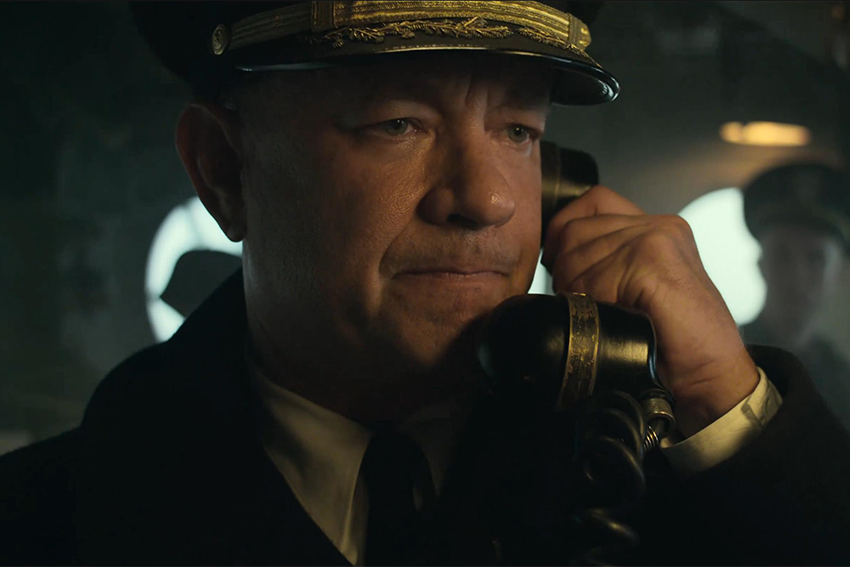
Q : this is a question for Blake Neely, there's been lots of lots and lots of war films how do you approach the creation of on an original score with the pressure of trying to bring something fresh to the table.
Blake Neely : well that's the pressure is to try to do something fresh and there have been so many war movies and there have been so many fantastic scores and i think that my approach is just to try to forget all of that and honor what's come before you but try to do your own thing and i can only really write me but that was definitely you know when Gary and Tom called there was hey we want a theme like from the pacific or like and that was actually the most terrifying part is can I can i do that again so it's i don't think it's any different than asking Mark or Mike what it's like to try to better your or Sydney to do you know one more war movie that's as good or better than some that came before but thankfully I was able to find that sweet spot.
(a short musical plays)
Blake Neely : it didn't come through very well but it was it's actually the beginning of that it's called Nightfall from the beginning of that scene that does pan up to the heavens and the aurora borealis.
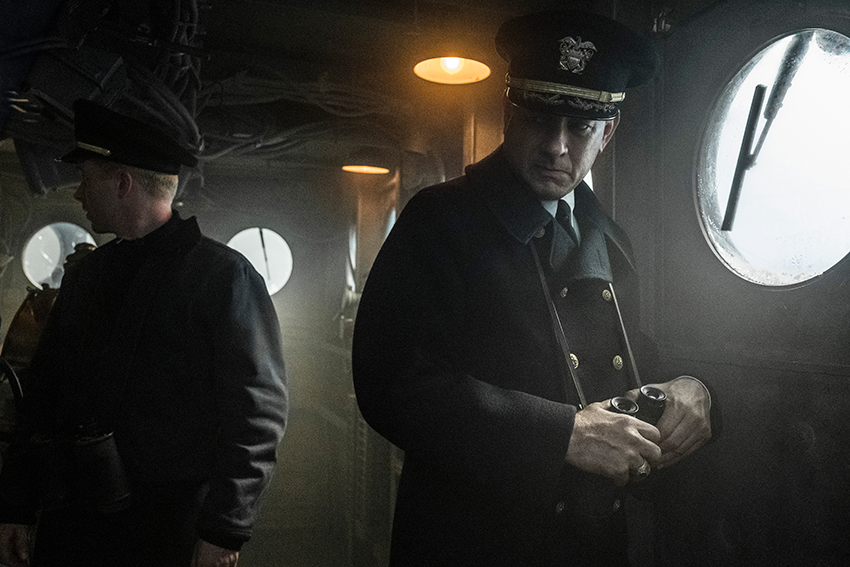
Synopsis :
A longtime Navy veteran who, as a first-time captain, is tasked with protecting a convoy of 37 ships carrying thousands of soldiers and much-needed supplies across the treacherous waters of the Atlantic during World War II. For five days with no air cover, the captain and his small force of three escort ships must make their way through an area of the ocean known as “the Black Pit,” battling Nazi U-boats while protecting their invaluable ships and soldiers. “Greyhound" is inspired by events during the Battle of the Atlantic, which took place in the earliest months of America’s alliance with Great Britain and the Allied Forces.
Greyhound
Directed by Aaron Schneider
Produced by Gary Goetzman
Screenplay by Tom Hanks
Based on The Good Shepherd by C. S. Forester
Starring Tom Hanks, Stephen Graham, Rob Morgan, Elisabeth Shue
Music by Blake Neely
Sound Designer : Michael Minkler
costume designer: Julie Weiss
Production designer : David crank
Cinematography : Shelly Johnson
Visual Effects Supervisors : Nathan McGuinness + Pete Bebb
Edited by Mark Czyzewski, Sidney Wolinsky
Production company : Sony Pictures Entertainment, Stage 6 Films, Bron Creative, Zhengfu Pictures, Sycamore Pictures, FilmNation Entertainment, Playtone
Distributed by Apple TV+
Release date : July 10, 2020 (United States)
Running time : 91 minutes

We would like to thanks Ivy Martinez for invite us to this virtual press conference and the different talents for answered to our questions.


